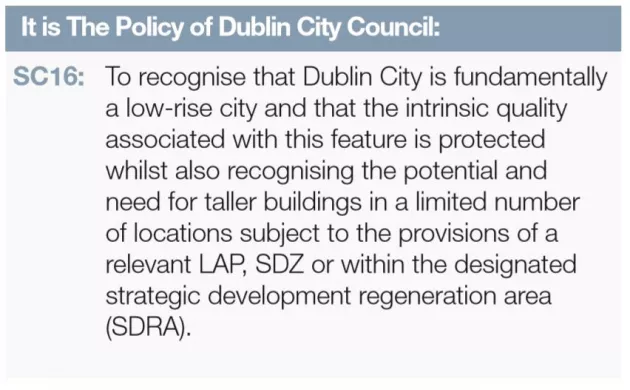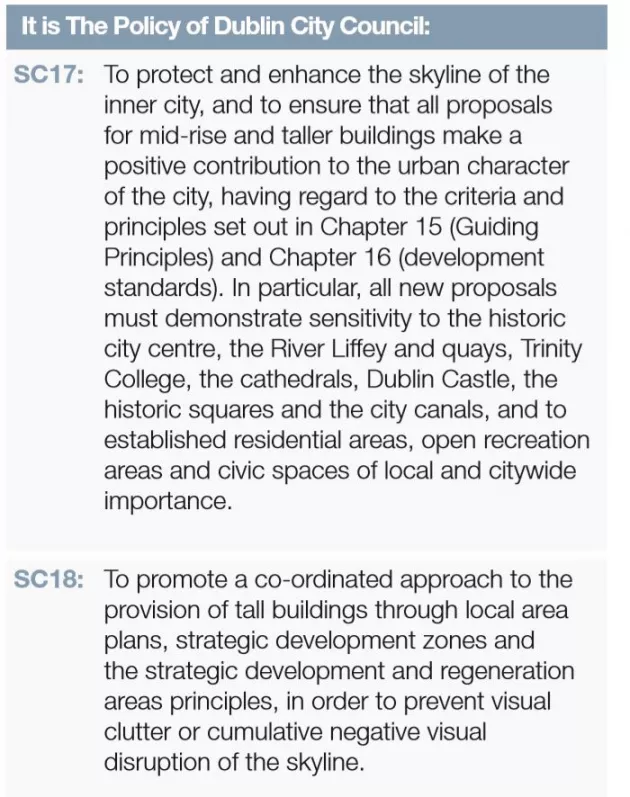4.5.4.1 Approach to Taller Buildings
4.5.4.1 Approach to Taller Buildings
Approach to Taller Buildings
Dublin City Council acknowledges the intrinsic quality of Dublin as a low-rise city and considers that it should remain predominantly so. The vast majority of the city area is identified as not being suitable for mid-rise or taller buildings. The City Council remains committed to the need to protect conservation areas, architectural conservation areas and the historic core of the city.
However, taller buildings can also play an important visual role and can make a positive contribution to the skyline of a city. Dublin City Council recognises the merit of taller buildings, including landmark buildings, in a very limited number of locations at a scale appropriate for Dublin. Accordingly, the spatial approach to taller buildings in the city is in essence to protect the vast majority of the city as a low-rise city, including established residential areas and conservation areas within the historic core, while also recognising the potential and the need for taller buildings to deliver the core strategy.
Clustering of taller buildings of the type needed to promote significant densities of commercial and residential space are likely to be achieved in a limited number of areas only. Taller buildings (over 50m) are acceptable at locations such as at major public transport hubs, and some SDRAs. For example, the North Lotts and Grand Canal Dock SDZ planning scheme provides for a limited number of tall buildings at Boland’s Mills, the Point, Spencer Dock Square and Britain Quay.
There are also a few areas where there are good transport links and sites of sufficient size to create their own character, such that a limited number of mid-rise (up to 50m) buildings will help provide a new urban identity. These areas of the city are the subject of a local area plan, strategic development zone or within a designated SDRA.
The review of the 2011 – 2017 development plan indicated that there are some anomalies in the height standards such that, for example, a 6-storey residential building at 19m high and a 7-storey office building, at 28m high, could potentially result in an incoherent streetscape. In addition, some uses, for example, hospitals or student halls of residence, do not fall conveniently into the conventional 3m storey height for residential schemes, and 4m storey height for commercial schemes. These anomalies are rectified by reference to maximum heights in metres only.
In all cases, proposals for taller buildings must respect their context and address the assessment criteria set out in the development standards section, to ensure that taller buildings achieve high standards in relation to design, sustainability, amenity, impacts on the receiving environment, and the protection or framing of important views. In addition, a set of development principles for each of the identified areas to inform LAPs, SDZs and SDRAs are set out in Chapter 15.
As such, it is policy to provide for taller buildings in those limited locations identified in the building height in Dublin map in order to promote investment, vitality and identity. Of the 14 specific areas identified for midrise (up to 50m) and taller (above 50m) buildings:
- 10 are in the mid-rise category of which 4 are in areas already the subject of local area plans
- 4 are in taller category, and comprise the Docklands Cluster, Connolly, Heuston and George’s Quay (part of the Docklands is covered by the SDZ planning scheme).
The guiding principles for development in SDRAs (Chapter 15) set out the locations for taller building in these areas. It is policy to retain the remaining areas of the city to a maximum height of between 16m to 28m depending on location, as set out in Chapter 16 (development standards).
In recognition of the national, social and cultural importance of the Liberty Hall site, the height limitations set out in the development plan may be set aside or relaxed in considering a proposal for the redevelopment of the site which will provide for the continuation of its national, historic, social and cultural status. Any such proposal will be considered against the relevant standards set out in the section dealing with the assessment criteria for high buildings

